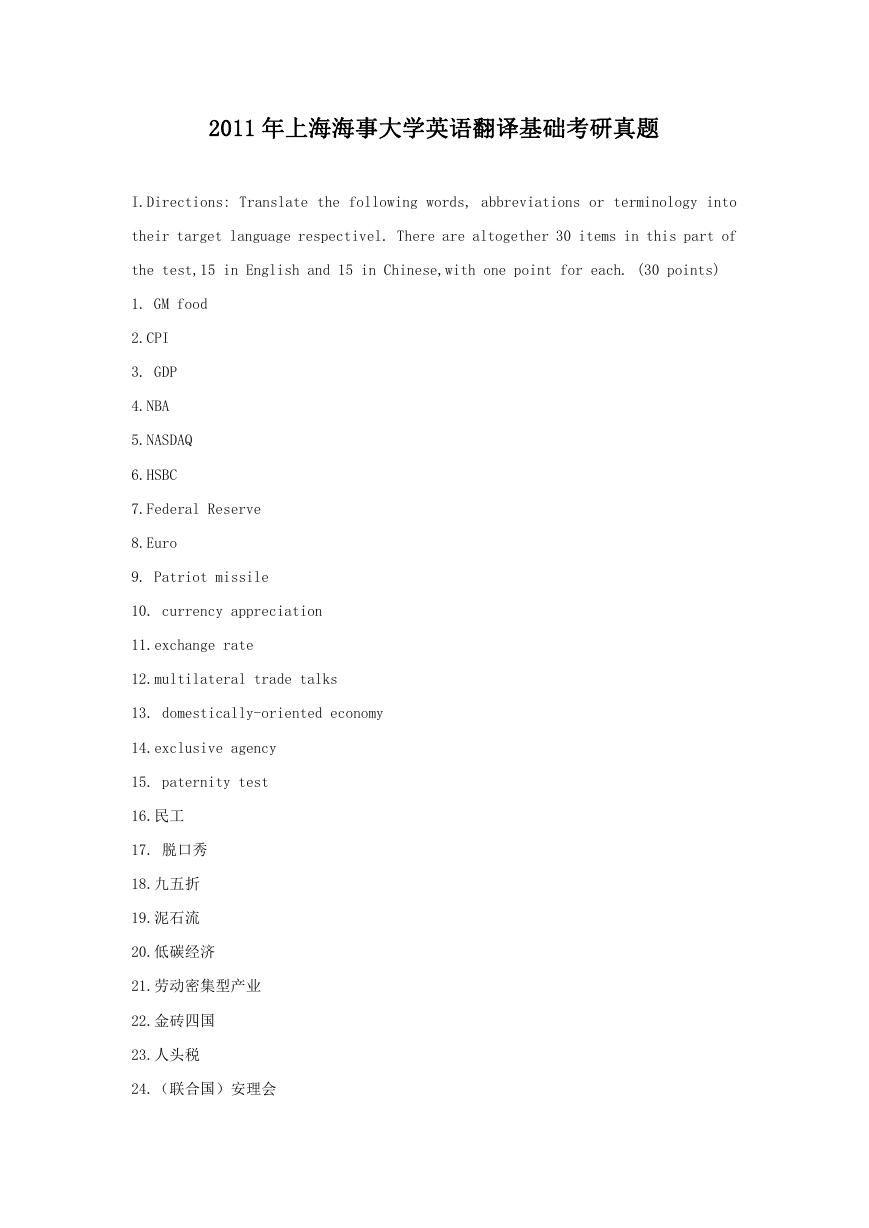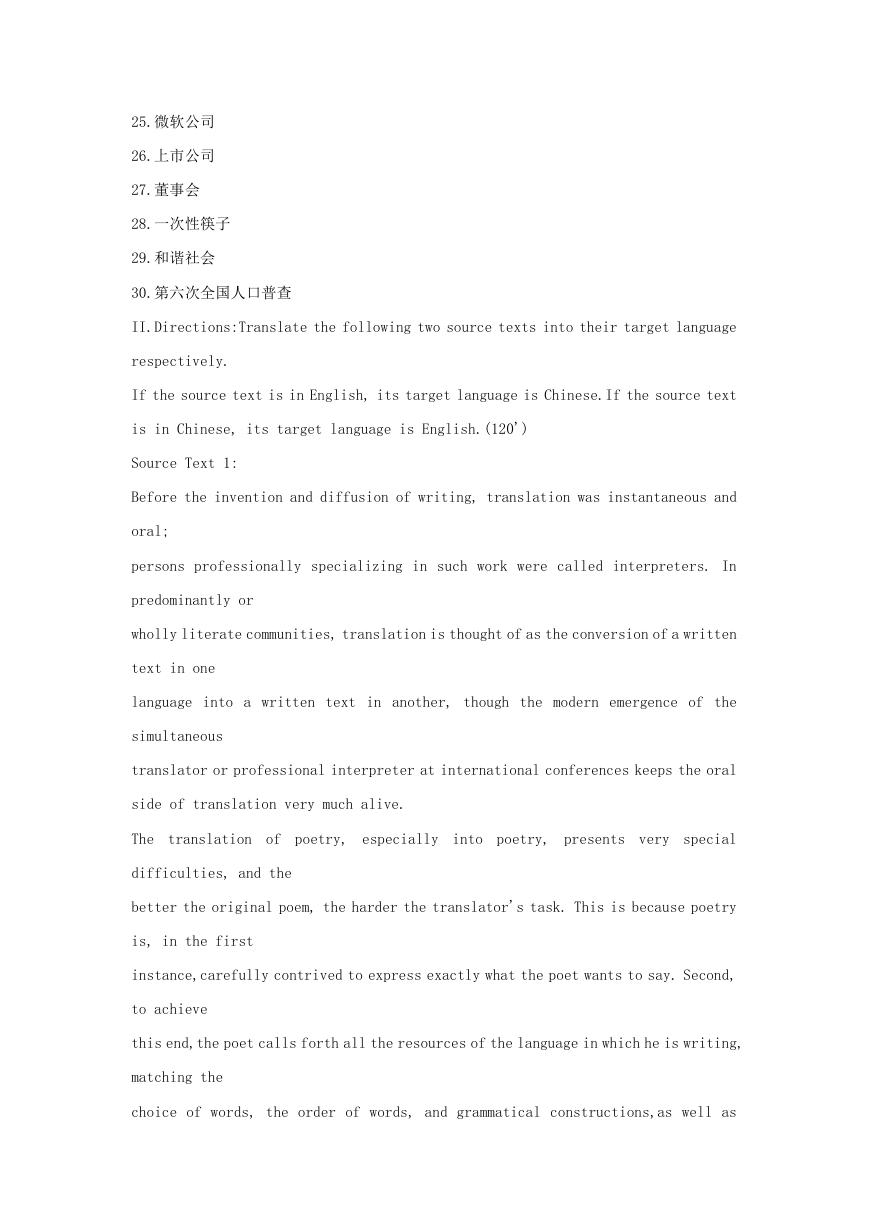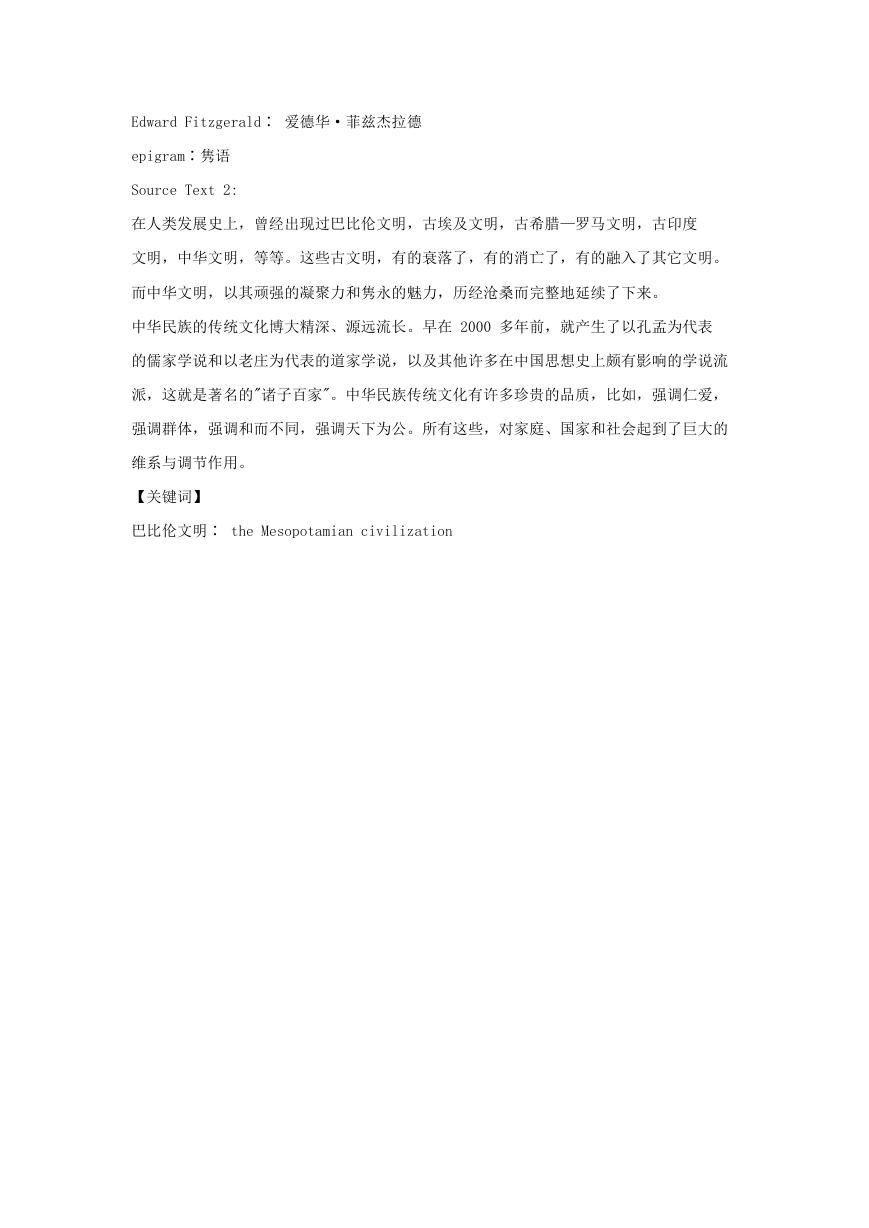2011 年上海海事大学英语翻译基础考研真题
I.Directions: Translate the following words, abbreviations or terminology into
their target language respectivel. There are altogether 30 items in this part of
the test,15 in English and 15 in Chinese,with one point for each. (30 points)
1. GM food
2.CPI
3. GDP
4.NBA
5.NASDAQ
6.HSBC
7.Federal Reserve
8.Euro
9. Patriot missile
10. currency appreciation
11.exchange rate
12.multilateral trade talks
13. domestically-oriented economy
14.exclusive agency
15. paternity test
16.民工
17. 脱口秀
18.九五折
19.泥石流
20.低碳经济
21.劳动密集型产业
22.金砖四国
23.人头税
24.(联合国)安理会
�
25.微软公司
26.上市公司
27.董事会
28.一次性筷子
29.和谐社会
30.第六次全国人口普查
II.Directions:Translate the following two source texts into their target language
respectively.
If the source text is in English, its target language is Chinese.If the source text
is in Chinese, its target language is English.(120')
Source Text 1:
Before the invention and diffusion of writing, translation was instantaneous and
oral;
persons professionally specializing in such work were called interpreters. In
predominantly or
wholly literate communities, translation is thought of as the conversion of a written
text in one
language into a written text in another, though the modern emergence of the
simultaneous
translator or professional interpreter at international conferences keeps the oral
side of translation very much alive.
The translation of poetry, especially into poetry, presents very special
difficulties, and the
better the original poem, the harder the translator's task. This is because poetry
is, in the first
instance,carefully contrived to express exactly what the poet wants to say. Second,
to achieve
this end,the poet calls forth all the resources of the language in which he is writing,
matching the
choice of words, the order of words, and grammatical constructions,as well as
�
phonological
features peculiar to the language in metre,perhaps supplemented by rhyme,
assonance,and
alliteration. The available resources differ from language to language.
At the other end of the translator's spectrum, technical prose dealing with
internationally
agreed scientific subjects is probably the easiest type of material to translate,
because cultural
unification (in this respect), lexical correspondences, and stylistic similarity
already exist in this
type of usage in the languages most commonly involved, to a higher degree than in
other fields
of discourse.
Translation on the whole is an art, not a science. Guidance can be given and general
principles can be taught, but after that it must be left to the individual's own
feeling for the two
languages concerned. Almost inevitably, in a translation of a work of literature
something of the
author's original intent must be lost; in those cases in which the translation is
said to be a better
work than the original, an opinion sometimes expressed about the English writer
Edward
Fitzgerald's"translation"of The Rubdiydt of Omar Khayam, one is dealing with a new,
though
derived,
work,not
just
a
translation.
The
Italian
epigram
remains
justified:Traduttore traditore
"The translator is a traitor."
[Key words]
diffusion∶传播
The Rubiiyat of Omar Khayyam∶ 《鲁拜集》
�
Edward Fitzgerald∶ 爱德华·菲兹杰拉德
epigram∶隽语
Source Text 2:
在人类发展史上,曾经出现过巴比伦文明,古埃及文明,古希腊—罗马文明,古印度
文明,中华文明,等等。这些古文明,有的衰落了,有的消亡了,有的融入了其它文明。
而中华文明,以其顽强的凝聚力和隽永的魅力,历经沧桑而完整地延续了下来。
中华民族的传统文化博大精深、源远流长。早在 2000 多年前,就产生了以孔孟为代表
的儒家学说和以老庄为代表的道家学说,以及其他许多在中国思想史上颇有影响的学说流
派,这就是著名的"诸子百家"。中华民族传统文化有许多珍贵的品质,比如,强调仁爱,
强调群体,强调和而不同,强调天下为公。所有这些,对家庭、国家和社会起到了巨大的
维系与调节作用。
【关键词】
巴比伦文明∶ the Mesopotamian civilization
�








 2023年江西萍乡中考道德与法治真题及答案.doc
2023年江西萍乡中考道德与法治真题及答案.doc 2012年重庆南川中考生物真题及答案.doc
2012年重庆南川中考生物真题及答案.doc 2013年江西师范大学地理学综合及文艺理论基础考研真题.doc
2013年江西师范大学地理学综合及文艺理论基础考研真题.doc 2020年四川甘孜小升初语文真题及答案I卷.doc
2020年四川甘孜小升初语文真题及答案I卷.doc 2020年注册岩土工程师专业基础考试真题及答案.doc
2020年注册岩土工程师专业基础考试真题及答案.doc 2023-2024学年福建省厦门市九年级上学期数学月考试题及答案.doc
2023-2024学年福建省厦门市九年级上学期数学月考试题及答案.doc 2021-2022学年辽宁省沈阳市大东区九年级上学期语文期末试题及答案.doc
2021-2022学年辽宁省沈阳市大东区九年级上学期语文期末试题及答案.doc 2022-2023学年北京东城区初三第一学期物理期末试卷及答案.doc
2022-2023学年北京东城区初三第一学期物理期末试卷及答案.doc 2018上半年江西教师资格初中地理学科知识与教学能力真题及答案.doc
2018上半年江西教师资格初中地理学科知识与教学能力真题及答案.doc 2012年河北国家公务员申论考试真题及答案-省级.doc
2012年河北国家公务员申论考试真题及答案-省级.doc 2020-2021学年江苏省扬州市江都区邵樊片九年级上学期数学第一次质量检测试题及答案.doc
2020-2021学年江苏省扬州市江都区邵樊片九年级上学期数学第一次质量检测试题及答案.doc 2022下半年黑龙江教师资格证中学综合素质真题及答案.doc
2022下半年黑龙江教师资格证中学综合素质真题及答案.doc